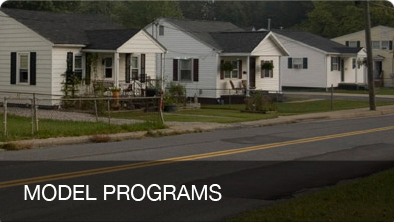Healthy Places
Our homes and our communities have enormous impact on our health. Living in unhealthy homes and communities can severely limit choices and resources. Healthy environments – including safe, well-kept housing and neighborhoods with sidewalks, playgrounds and full-service supermarkets – encourage healthy behaviors and make it easier to adopt and maintain them. To improve health we must promote health where we live, learn, work and play. The Commission recommends:
RECOMMENDATION: Create “healthy community” demonstrations to evaluate the effects of a full complement of health-promoting policies and programs. Demonstrations should integrate and develop successful models that can be widely implemented and that include multiple program approaches and sources of financial support. Each “healthy community” demonstration must bring together leaders and stakeholders from business, government, health care and nonprofit sectors to work together to plan, implement and show the impact of the project on the health of the community.
RECOMMENDATION: Develop a “health impact” rating for housing and infrastructure projects that reflects the projected effects on community health and provides incentives for projects that earn the rating. All homes, workplaces and neighborhoods should be safe and free from health hazards. Communities should mobilize to correct severe physical deficiencies in housing, and health should be built into all efforts to improve housing, particularly in low-income neighborhoods. New federal housing investments should be held accountable to demonstrate a health impact.
RECOMMENDATION: Integrate safety and wellness into every aspect of community life. While much remains to be done to create safe and health-promoting environments, many schools, workplaces, and communities have shown the way, with education and incentives for individuals, employers, and institutions and by fostering support for safety and health in schools, workplaces and neighborhoods. Funding should go only to organizations and communities that implement successful approaches and are willing to be held accountable for achieving measurable improvements in health.

The Boston One Touch Program
The Boston One Touch Program seeks to leverage and coordinate the efforts of city and state government and community advocacy groups to improve the health of children from lower-income families. Read more
Bethel New Life
A faith-based community development organization in the West Garfield Park neighborhood of Chicago, Bethel New Life led a transit-oriented design initiative when the Chicago Transit Authority threatened to discontinue train service through the neighborhood. Read more
Arabia Mountain Trail
The Arabia Mountain Trail, built in an African-American community east of Atlanta, has measurably increased physical activity for residents by connecting neighborhoods, downtown and commercial areas with large nature preserves and historic sites. Read more
Related Resources
-

Across America, Differences in How Long and How Well We Live
Where we live, work, learn and play dramatically affects our health—for better or for worse. Across America and within every state, there are differences in how long and how well we live. This map and accompanying chart show the highest and lowest life expectancy rates (based on county-level data) found in each state and the District of Columbia.
-

A Short Distance to Large Disparities in Health
Life span disparities reflect differences in wealth, education and environment across all community residents. The differences are even more dramatic - sometimes double - if you compare black and white residents.
-

Denver: Where You Live Matters
In the Denver metropolitan area, life expectancy can vary by more than five years depending on where you live. Promising workplace programs in Colorado—designed to protect and promote workers’ health—are striving to decrease these gaps and increase people’s chances of living healthier and longer lives.
More Resources